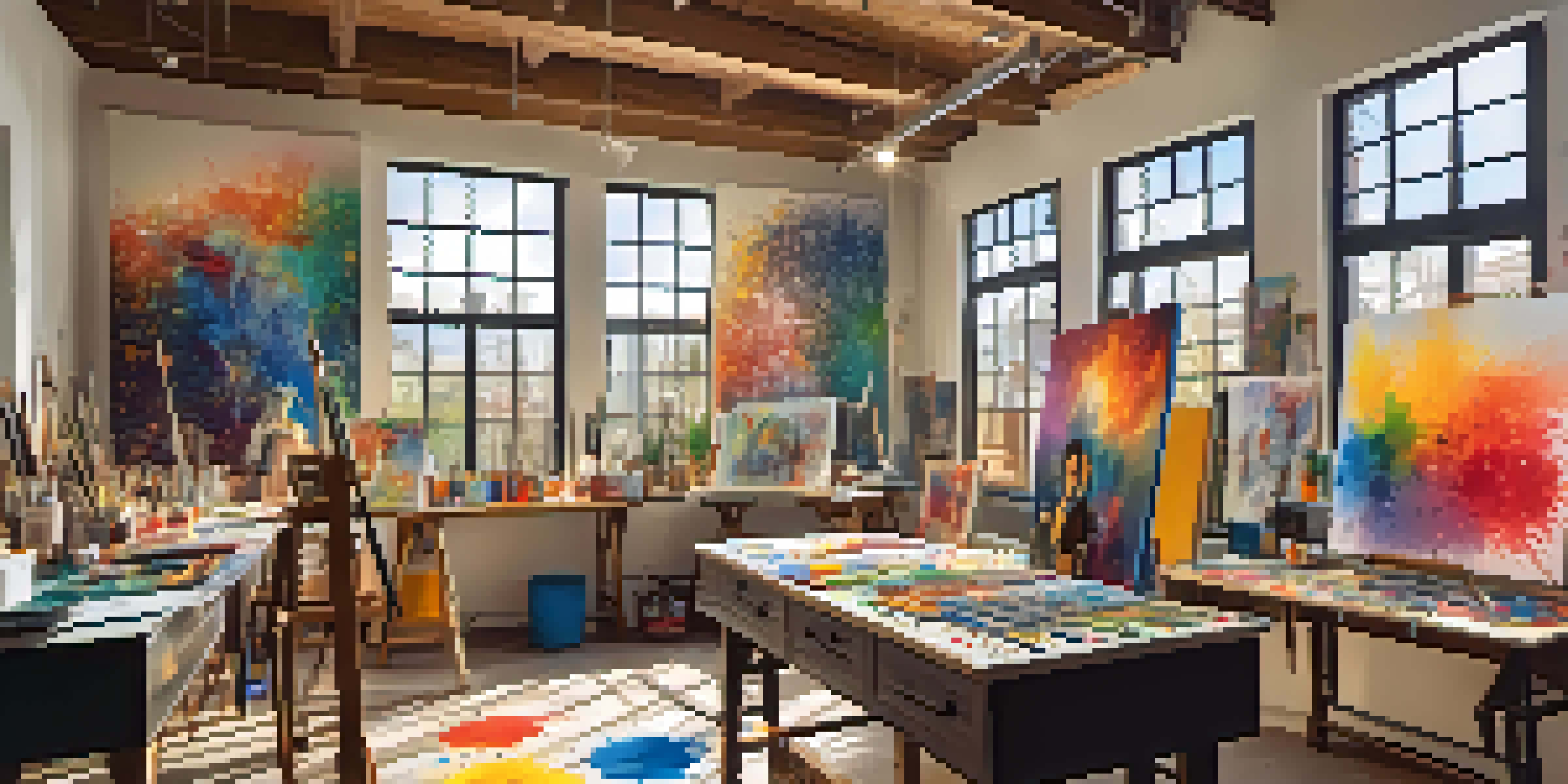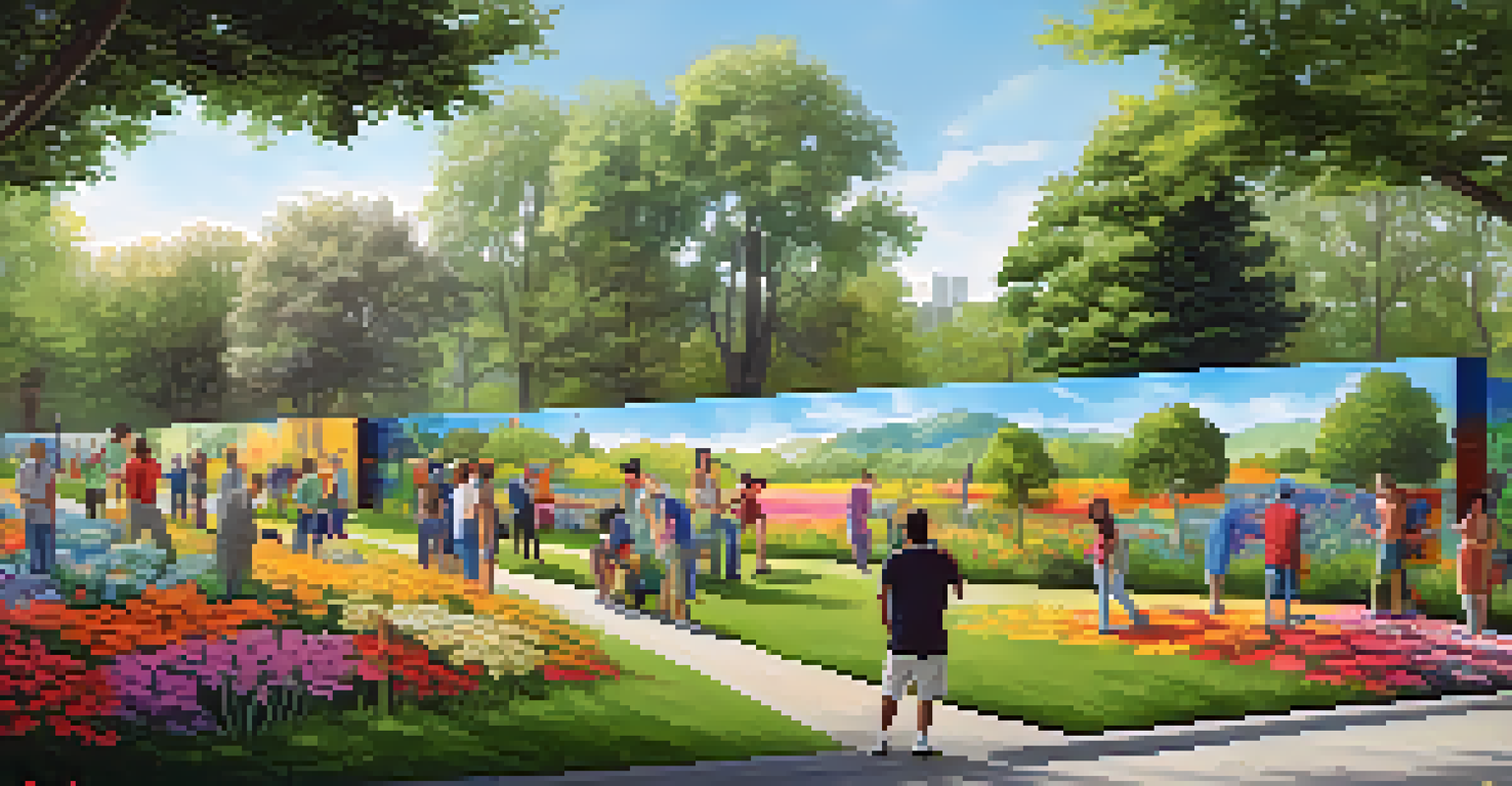Collaboration Between Artists: A Path to Creative Innovation

The Power of Collaboration in Art
Collaboration among artists can lead to remarkable outcomes, blending unique perspectives and styles. When artists come together, they create a synergy that often sparks innovative ideas that one might not conceive alone. This fusion of creativity can push boundaries, allowing for the exploration of new techniques and themes.
Collaboration allows us to know more than we are capable of knowing by ourselves.
Think of it like a potluck dinner where everyone brings their favorite dish; the meal becomes richer and more varied than any single contribution. Artists can take inspiration from each other’s strengths and experiences, enhancing their work in unexpected ways. This collaboration often results in pieces that resonate on a deeper level with audiences.
Moreover, working collectively can offer artists support and encouragement, fostering a sense of community. In an industry that can sometimes feel isolating, collaboration helps artists feel connected and motivated. Together, they can celebrate successes and navigate challenges, leading to more sustained creative output.
Historical Examples of Artistic Collaboration
Throughout history, many iconic art movements have emerged from collaboration. The Impressionists, for example, often painted alongside each other, sharing techniques and ideas that revolutionized how we perceive light and color. This cooperative spirit not only changed individual practices but also transformed the art world as a whole.

Another notable example is the collaboration between artists Jean-Michel Basquiat and Andy Warhol in the 1980s. Their partnership blended street art and pop culture, resulting in a fresh aesthetic that challenged traditional notions of fine art. This synergy not only enriched their own portfolios but also left a lasting impact on contemporary art.
Collaboration Sparks Creativity
When artists collaborate, they blend unique perspectives, leading to innovative ideas and enriched artistic expression.
These historical collaborations remind us that great art often arises from shared experiences and mutual inspiration. They illustrate that when artists unite, they can create movements that resonate beyond their individual contributions, making lasting marks on culture and society.
Modern Platforms for Artist Collaboration
In today's digital age, artists have more opportunities than ever to collaborate. Online platforms like social media and art-sharing websites allow artists from different backgrounds and locations to connect effortlessly. This accessibility paves the way for diverse collaborations that might not have been possible in the past.
Great things in business are never done by one person; they're done by a team of people.
For instance, artists can join virtual workshops, participate in joint exhibitions, or even co-create digital artworks in real-time. These platforms serve as a bridge, allowing artists to share ideas and techniques across borders. This global dialogue fosters innovation and helps to cultivate a rich tapestry of artistic expression.
Furthermore, the rise of collaborative projects like community murals or public art installations has made art more inclusive. Artists are now encouraged to engage with their communities, leading to artwork that reflects collective narratives and experiences. This not only enhances the creative process but also strengthens community bonds.
The Role of Technology in Artistic Collaboration
Technology has revolutionized how artists collaborate, providing tools that enhance creativity. Software like Adobe Creative Cloud and various design apps allow multiple artists to work on projects simultaneously, regardless of their physical locations. This means that artists can contribute their unique touches to a piece without the constraints of geography.
In addition, advancements in virtual reality (VR) and augmented reality (AR) are creating new avenues for collaboration. Artists can now create immersive environments that combine their individual artistic visions into a cohesive experience. This not only expands the possibilities for artistic expression but also captivates audiences in unprecedented ways.
Technology Enhances Collaboration
Advancements in technology provide tools that allow artists to work together seamlessly, regardless of distance.
These technological tools empower artists to push the envelope of what’s possible, making collaboration more dynamic and versatile. As artists adapt to these new resources, the potential for innovative projects continues to grow, encouraging creativity that is both collaborative and cutting-edge.
Building a Collaborative Mindset
To truly benefit from collaboration, artists must adopt a collaborative mindset. This means being open to feedback, willing to share ideas, and ready to embrace different perspectives. It’s essential to approach partnerships with a spirit of curiosity and willingness to learn from one another.
A good way to cultivate this mindset is through active listening. By genuinely engaging with fellow artists, one can better understand their visions and techniques. This deeper connection can lead to more meaningful collaborations, enriching the creative process and resulting in exceptional work.
Moreover, artists should also be prepared to step outside their comfort zones. Trying new techniques or exploring unfamiliar themes with a partner can lead to unexpected breakthroughs. Embracing risk is a crucial part of the collaborative journey, often resulting in innovative and exciting art.
The Challenges of Artistic Collaboration
While collaboration can be incredibly rewarding, it also comes with its own set of challenges. Differing artistic visions can sometimes lead to conflicts, requiring open communication to navigate. Establishing clear goals and expectations at the beginning of a project can help mitigate misunderstandings down the line.
Additionally, artists may struggle with balancing their individual styles with the collaborative piece. It’s important to find a harmonious blend that respects each artist’s contributions while also creating something new. This balance can be tricky but is essential for a successful collaboration.
Mindset is Key for Success
A collaborative mindset, characterized by openness and willingness to learn, is essential for fruitful artistic partnerships.
Finally, time management can pose a challenge when working with others. Coordinating schedules and aligning timelines can be difficult, especially if artists are juggling multiple projects. However, by setting clear deadlines and maintaining open communication, artists can ensure that their collaborative efforts remain on track.
Celebrating Successful Collaborations
Celebrating the success of collaborative projects is vital for fostering future partnerships. Acknowledging each artist’s contributions not only strengthens relationships but also builds a sense of community. Whether through exhibitions, social media shout-outs, or interviews, sharing the success of a collaboration can inspire others to engage in similar endeavors.
Moreover, showcasing the work can attract new audiences, allowing even more people to appreciate the creativity that arises from collaboration. It’s a wonderful opportunity to highlight how diverse perspectives can come together to create something extraordinary. As word spreads, it encourages other artists to explore collaborative possibilities.

In essence, celebrating collaboration not only honors the work produced but also amplifies the message that collective creativity can lead to innovative solutions. It fosters a culture of openness and experimentation, propelling the art world forward into new realms of expression.